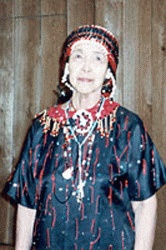|
"The tradition of storytelling is intrinsic in all Alaska Native cultures. It has been used since ancient times to tell about family histories, life lessons, tell of valuable role models, mythology, and entertainment. The stories of any people tell a great deal about their culture."
-- Alaska Native Heritage Center
Meet Lucille Davis, an Alutiiq elder originally from the village of Karluk, located on the southwest side of Kodiak Island. Davis serves on the Kodiak and Afognack elders council, and has been sharing stories about her life on Kodiak Island for many years.
 |
| Lucille Davis |
 |
Today, at the Alaska Native Heritage Center Davis is seated in the Gathering Place, a round room where light from the setting sun shines brightly through floor to ceiling windows that overlook Tiulana Lake. She is a petite woman; lines around her mouth and eyes map years of experience and wisdom. She wears a shiny red dress; her head is covered with beads and her neck shines with jewelry. She smiles at those who have come to hear her stories and begins to speak.
Davis talks about the homes that her people, the Alutiiq, live in, underground, so they are well insulated by the earth during the long, harsh winters. Also, because many Alutiiq peoples live on islands, there is not much wood to use for building a home; all excess wood must be saved for making tools and boats. Because of the lack of wood, Davis' village does not use fire to keep warm; instead, they carved shallow places into chunks of soapstone and filled them with seal oil and a wick, lighting them just like an oil lamp. One stone about the size of a dinner plate could heat and give light to the whole underground home.
There was no ivory on Kodiak Island while Davis grew up there, so tools were all made of bone. Davis has many artifacts to show while she talks, things found when she helped some archeologists conduct a dig around her home. She shows us tools that were at least 4,000 years old! She has a spool for thread, a nail, a knife handle, and a clothespin, all carved out of bone.
Davis also tells us about her father, the chief and doctor of her village, the man to whom the sick would come. She explains that people used to come to him with bruises and broken bones, and he would take a hollowed bone and place it over their wound, and inhale deeply over it, thus drawing the blood away from the area and reducing sensation, a kind of Native novocaine. He would then take a small knife, carved from bone, with a wooden handle, to lance the wound, draining some blood into a soap stone dish. This blood would be taken to sit in the back of the home for two nights. On the third day, Davis' father would take the blood, and if it was congealed and dry, there was no infection. However, if there was a small amount of water sitting on the surface of the blood, there was an infection; Davis' father would then treat his patient with herbs.
Alaska Native Storytellers have much to share about their history, their culture, and their values. To find out when the next storyteller is going to be at the Alaska Native Heritage Center, visit their web site at www.alaskanative.net. Or give them a call at (907) 330-8000.
|
 |
|




